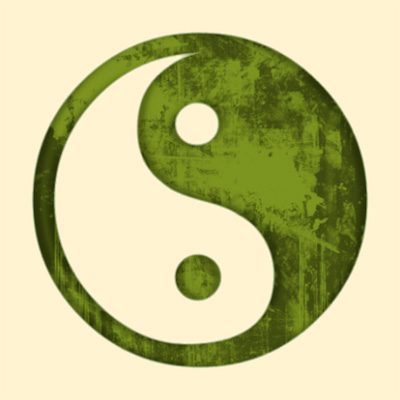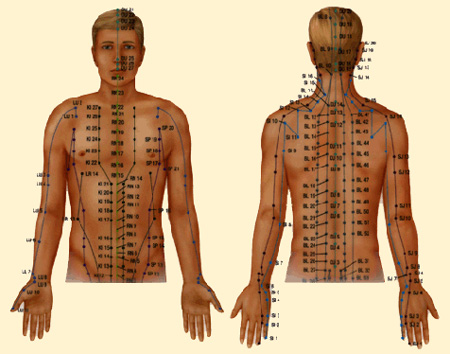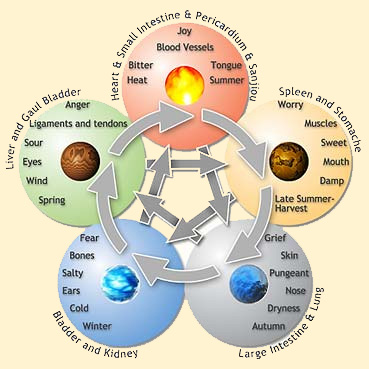Introduction and History
Acupuncture, as the main form of therapy in traditional Chinese medicine (TCM), has been practiced for about 5000 years. The first book published and dedicated to TCM and acupuncture is “Huang Di Nei Jing” attributed to “The Yellow Emperor” dating back to 2500 years ago. In acupuncture, certain points on the body associated with subtle energy channels (meridians) are stimulated by the insertion of fine needles. Unlike the hollow hypodermic needles used in mainstream medicine to give injections or draw blood, acupuncture needles are solid. The points can be needled between 15 and 90 degrees in range relative to the skin's surface, depending on treatment.

The two opposite, yet completing forces of nature are the foundation of life
Acupuncture restores health by removing energy imbalances and blockages in the body. According to the theory of TCM , there is a vital force or energy called qi that flows through the body and between the skin surface and the internal organs, along channels or pathways called meridians. There are 12 major and 8 minor meridians. Qi regulates the spiritual, emotional, mental, and physical harmony of the body by keeping the forces of YIN and YANG in balance. Yang is a principle of heat, activity, brightness, outwardness, while yin represents coldness, passivity, darkness, interiority, etc. TCM does not try to eliminate either yin or yang, but to keep them in harmonious balance. Acupuncture may be used to raise or lower the level of yin or yang in a specific part of the body in order to restore the energy balance.
Acupuncture was virtually unknown in the United States prior to President Nixon's trip to China in 1972. A reporter for the New York Times named James Reston wrote a story for the newspaper about the doctors in Beijing who used acupuncture to relieve his pain following abdominal surgery for Appendectomy . By 1993, Americans were making 12 million visits per year to acupuncturists, and spending $500 million annually on acupuncture treatments. By 1995, there were an estimated 10,000 certified acupuncturists practicing in the United States; as of 2000, there were 20,000. About a third of the credentialed acupuncturists in the United States as of 2002 are MDs.
Acupuncture's record of success has been sufficiently impressive to stimulate a number of research projects investigating its mechanisms as well as its efficacy. In 1997 a consensus panel of the National Institutes of Health (NIH) presented a landmark report in which it described acupuncture as a sufficiently promising form of treatment to merit further study. In 2000, the British Medical Association (BMA) recommended that acupuncture should be made more readily available through the National Health Service (NHS), and that family doctors should be trained in some of its techniques.
Medical Applications
In western countries, acupuncture is used most commonly as an adjunctive treatment for the relief of chronic or acute pain. In the United States, acupuncture is most widely used to treat pain associated with musculoskeletal disorders, but it has also been used in the treatment of substance abuse, and to relieve nausea and vomiting. A study done in 2001 showed that acupuncture was highly effective in stopping the intense vomiting associated with a condition in pregnant women known as hyper emesis gravidarum. In the past several years, acupuncture has been tried with a new patient population, namely children with chronic pain syndromes. One study of 30 young patients with disorders ranging from migraine headaches to endometriosis found that 70% felt that their symptoms had been relieved by acupuncture, and described themselves as "pleased" by the results of treatment. In addition to these disorders, acupuncture has been used worldwide to treat asthma, infertility, depression, anxiety, fibromyalgia, menstrual cramps, carpal tunnel syndrome, tennis elbow, frozen shoulder, chronic fatigue syndrome, and postoperative pain.
Mechanisms of Action
From the western medicine’s point of view ,the exact mechanism by which acupuncture works is not completely and clearly known. Western researchers have already suggested three basic explanations of acupuncture's efficacy in pain relief:
- Western studies have found evidence that the traditional acupuncture points conduct electromagnetic signals. Stimulating the acupuncture points causes these signals to be relayed to the brain at a higher than normal rate. These signals in turn cause the brain to release pain-relieving chemicals known as endorphins, and immune system cells to weak or injured parts of the body.
- Other studies have shown that acupuncture activates the release of opioids such as beta endorphins into the central nervous system. Opioids are also analgesic, or pain-relieving compounds.
- Acupuncture appears to restore the chemical balance of the brain itself by modifying the production and release of neurotransmitters and neurohormones. Acupuncture has been documented to affect certain involuntary body functions, including immune reactions, blood pressure, and body temperature.
In addition to its efficacy in relieving pain and other chronic conditions, acupuncture has gained in popularity worldwide because of several additional advantages:
- It lacks the side effects associated with many medications and surgical treatments in Western medicine.
- It is highly cost-effective; it may be used early in the course of a disease, potentially saving the patient the cost of hospitalizations, laboratory tests, and high-priced drugs.
- It can easily be combined with other forms of therapy, including psychotherapy.
- It can be performed by modalities other than stainless steel needles such as LASER in case of needle phobia.
- It has no interactions with other complementary therapies or western medicine.
- It carries very few risks if performed by professionals.
- Most of the patients feel energized and more in harmony following acupuncture treatments , leading to better quality of life .
Precautions
Although the risk of infection in acupuncture is minimal, patients should make sure that the acupuncturist uses sterile disposable needles. In the United States, the Food and Drug Administration (FDA) mandates the use of sterilized needles made from nontoxic materials. The needles must be clearly labeled as having their use restricted to qualified practitioners. Patients should also inquire about the practitioner's credentials.
Patients seeking acupuncture treatment should provide the practitioner with the same information about their health conditions and other forms of treatment that they would give their primary care doctor. This information should include other alternative and complementary therapies, especially herbal remedies.
Acupuncture should not be used to treat severe traumatic injuries and other emergency conditions requiring immediate surgery. It is also not the treatment of choice for patients with pacemakers. Patients who are pregnant should inform their acupuncturist of this fact, so that some special acupoints may not be used during the treatment sessions.
As is true with other forms of medical treatment, a minority of patients do not respond to acupuncture. The reasons for nonresponsiveness are not known at the present stage of research.
Diagnosis
In traditional Chinese medicine, acupuncture treatment begins with a thorough physical examination in which the practitioner evaluates the patient's tongue color and coating. The practitioner then takes the patient's pulse at six locations and three depth levels on each wrist. These thirty-six pulse measurements will tell the practitioner where the qi in the patient's body might be blocked or unbalanced. After collecting this information, the acupuncturist will then identify the patterns of energy disturbance and the acupuncture.
In our clinic, we perform in depth analysis of the main 12 meridians using modern diagnostic measurements before starting the treatments. Thus, the patient will be informed of his/her meridian bio- energy levels as well as mental/emotional well being by the Electro dermal analysis (EDA). Then the patient would be advised to follow a complete lifestyle including nutrition, physical exercise, mental techniques, music and aromas, according to their specific measurements and their individual element from the cycle of five elements in Traditional Chinese Medicine.

Traditional Chinese medicine teachings state that channels of energy flow throughout the body,and that disease is caused by too much or too little flow of energy along these channels. Points along the channels, called meridians, are manipulated in acupuncture.

Yin and Yang are transformed into 5 elements (fire,earth,metal,water,wood) in the material world . Human body is also combined of important organs, each related to a specific element.
Treatment
The objective of treatment is restoring the balance between Yin and Yang together with promoting the flow of qi in meridians and organs. Points that should be stimulated to unblock the qi or restore harmony are mainly selected during the first session. Up to ten acupuncture needles may be inserted at strategic points along the relevant meridians and rotated as they are inserted in order to create “De qi effect”. This term defines the tingling, distending or warming sensation felt by the patient followed by stimulation of the needles which guarantees better therapeutic results. Few patients may feel nothing at all during this procedure but feel the eventual feeling of being relaxed and energized at the end of the session, although others experience a prickling or mild aching or distending sensation, feeling of warmth, heaviness or flow of energy in their body during the session.
The practitioner may combine acupuncture with moxibustion to increase the effectiveness of the treatment. Moxibustion is a technique in which the acupuncturist lights a small cigar shaped pack of dried leaves of “Artemesia Vulgaris” named moxa above the acupuncture point above the skin. When the patient begins to feel the warmth from the burning herb, it is removed. Cupping is another technique that is a method of stimulation of acupuncture points by applying suction through a glass or plastic jar. Producing blood congestion at the site, the site is thus stimulated. The method is used for lower back pain, sprains, soft tissue injuries, as well as relieving fluid from the lungs in chronic bronchitis.
Acupuncture points may also be stimulated by modern devices such as Low level LASER (LLLT) , Infra red (IR) , visible light spectrum (Color therapy) , magnets and electromagnetic fields (EMF) in order to obtain the same results .
In addition to the traditional Chinese techniques of acupuncture, the following are also used worldwide:
- Ear acupuncture : This technique regards the ear as having acupuncture points that correspond to other parts of the body. Ear acupuncture is often used to treat substance abuse and chronic pain syndromes.
- Electro acupuncture : In this form of acupuncture, the traditional acupuncture points are stimulated by an electronic device with D.C. electricity instead of a needle.
- Japanese meridian acupuncture : Japanese acupuncture uses thinner, smaller needles, and focuses on the meridians rather than on specific points along their course.
- Korean hand acupuncture : Traditional Korean medicine regards the hand as a "map" of the entire body, such that any part of the body can be treated by stimulating the corresponding point on the hand.
- Western medical acupuncture : Western physicians trained in this style of acupuncture insert needles into so-called trigger points in sore muscles, as well as into the traditional points used in Chinese medicine.
A standard acupuncture treatment in U.S. usually costs $40 to $100, although initial appointments often cost more. Chronic conditions usually require 10 treatment sessions, but acute conditions or minor illnesses may require less visits. Follow-up visits are often scheduled for patients with chronic pain. As of 2000, about 70%–80% of health insurers in the United States accepted patients for acupuncture treatments.
References for further study :
A Manual of Acupuncture, by Peter Deadman and Mazin Al-Khafaji (East Sussex, England: Journal of Chinese Medicine Publications, 1998). A detailed guidebook to descriptions of the theories and actual specific methods of acupuncture. It provides information on the c channels, collaterals. point categories, point selection methods, point location, and needling.
Basics of Acupuncture, by Gabriel Stux (Editor) and Bruce Pomerantz (Berlin, Germany: Springer Vertigo 1995). The most recent of several widely used texts by acupuncture researchers.
Between Heaven and Earth: A Guide to Chinese Medicine, by Harriet Beinfield and Efrain Korngold (New York, NY. Ballantine Books, 1991). An overview of Chinese medicine, with case histories of treatments and illustrated explanations of philosophy, components, and treatments.
Principles and Practice of Contemporary Acupuncture, by Sung J. Liao, Matthew Lee, and Lorenz K.Y Ng (New York, NY: Marcel Dekker, 1994). Contains translations of ancient Chinese medical classics previously unavailable in English. Compares and contrasts traditional Chinese and Western scientific medicine.
The Chinese Way to Healing - Many Paths to Wholeness, by Misha Ruth Cohen (New York, NY: The Berkeley Publishing Group, 1996). A guidebook to Chinese medicine in the United States with information about diet herbs, acupuncture, and finding qualified practitioners.
The Web That Has No Weaver, by Ted Kaptchuk (New York-, NY: Congdon and Weed, 1992). An introduction to traditional Chinese medicine, with comparisons of Eastern and Western medical treatments.
The Yellow Emperor's Classic of Internal Medicine, by Maoshing Ni, (Boston, MA: Shambala Press, 1995). A contemporary translation of the classic traditional Chinese medicine text that dates from 2000 B.C.
Combination of acupuncture with colored light therapy:
http://acupuncturejournal.com/AJASple3.html
www.ncbi.nlm.nih.gov/pubmed/10513100
Educational Videos on Acupuncture and TCM :
http://www.youtube.com/watch?v=l2tX-vhREVo